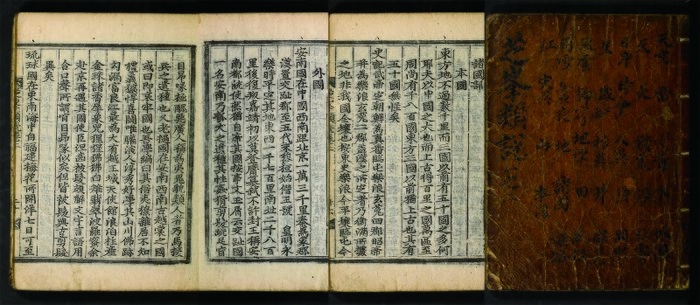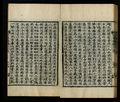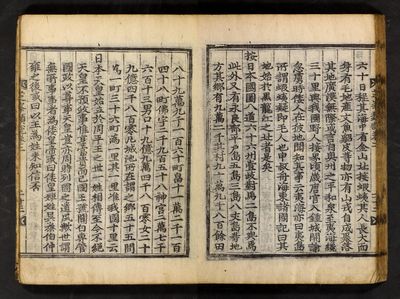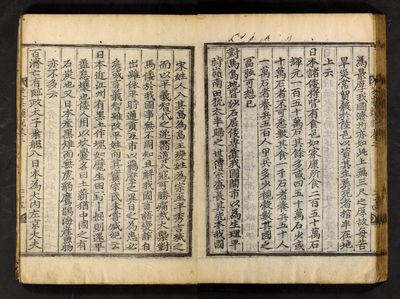(Translation) 李睟光 外國2
| Primary Source | ||
|---|---|---|
 |
Title | |
| English | ||
| Chinese | 芝峯類說 | |
| Korean(RR) | 지봉유설(Jibongyuseol) | |
| Text Details | ||
| Genre | Literati Writings | |
| Type | ||
| Author(s) | 李睟光 | |
| Year | ||
| Source | ||
| Key Concepts | ||
| Translation Info | ||
| Translator(s) | Participants of 2018 Summer Hanmun Workshop (Advanced Translation Group) | |
| Editor(s) | ||
| Year | 2018 | |
목차
Introduction
Original Script
Discussion Questions
Further Readings
References
Translation
(sample) : Jaeyoon Song
- Discussion Questions:
Student 2 : Ze, Xiaoyi
6. 日本舊名倭奴。漢武時始通中國。至唐改號日本。東西五千餘里。南北數百里。唯東山東海等道。南北千餘里。以其南北狹東西長。故謂之一字國。漢書曰。倭王居邪馬臺。續文獻通考曰。倭奴有百餘國。一曰邪馬。姜沆聞見錄云倭王舊都曰野馬臺。有四百八十寺。極其華麗。蓋與南朝四百八十寺相埒耳。
Japan is used to be named as Wa state. It started contacts with China during the Han dynasty and changed its name to Japan during the Tang dynasty. It is as far as more than five thousand Li from east to west, hundreds of li from south to north. Only its eastern mountains and eastern sea regions are 唯東山東海等道。南北千餘里。Because it is narrow from south to north and wider from east to west, it is named as the state of One (Chinese character). According to Book of Han, the King of Wa state reside in 邪馬臺. According to the (Reorganization and Studies)General Rectification of Literature, Wa people have hundreds of states, and 邪馬 is one of them. According to 姜沆聞見錄, the old capital of the Wa King was named as 野馬臺. It has four hundred and eighty extremely splendid temples, which can be compared with the four hundred and eighty temples of the Southern dynasties.
7. 日本一州爲一國。而陸奧州最大。管五十四郡。東西"六十日程。其海中有金山。北接蝦蛦。其人長大而身有毛。地産文魚貂皮等物。亦有山戎自成聚落。其地廣漠無際。或言自奧州之平和泉。至夷海纔三十里。與我國野人接界。頃歲唐官入鍾城。開諭忽虜時。倭人在彼地。聞知其事云。夷海亦曰夷島。所謂蝦蛦。疑卽毛人也。申叔舟海東諸國記曰。其地始於黑龍江之北者是矣。
In Japan, one region is one state, and 陸奧州 is the biggest state. It is in charge of fifty-four counties, sixty-day farther from the east to west. It has a golden mountain in the ocean, and its northern area connects to Emishi. Its people are tall and big, with hairy body. It is famous for local productions of fish and mink. Nomadic people of Shanrong also live there, with their own communities. Its land is broad and endless, or it can be compared to ….. Around thirty Li to 夷海, it connects with the nomadic people of our state. Recent years, when the Tang envoys visited 鍾城, 開諭忽虜時。倭人在彼地。聞知其事云。夷海亦曰夷島。 As for 蝦蛦,they look like the 毛人. Accoring to 申叔舟’s 海東諸國記, its land began from the north of Heilongjiang.
8. 按日本國圖。八道六十六州。壹岐,對馬二島不與焉。此外又有永良部,平戶島,五島,三島,八丈島等地方。其鄕有九萬二千。其村九十萬九千八百餘。田八十九萬九千一百六十町。 fields畠十一萬二千一百四十八町。佛宇二千九百五十八。神宮二萬七千六百十三。男口十九億九萬四千八百零。女二十九億四千八百零。凡城池所在。謂之鄕。五十五間爲一町。三十六町爲一里。其一里准我國十里云。
According to the map of the state of Japan (based on my observation of Japanese map), it has eight provinces and sixty-six prefectures. The island of 壹岐 and對馬 do not belong to it. Besides, it includes areas such as 有永良部,平戶島,五島,三島,八丈島. Japan has ninety-two thousand counties and more than nine million nine thousand and eight hundred districts. There are田八十九萬九千一百六十町。畠十一萬二千一百四十八町, two thousand nine hundred fifty-eight temples and twenty-seven thousand six hundred and thirty shrines. Its male population is nineteen billion ninety-four thousand eight hundred and female population is twenty-nine billion four thousand eight hundred. 凡城池所在。謂之鄕。五十五間爲一町。三十六町爲一里。It is said that one Li is equal to ten Li in our state.
- Discussion Questions:
Student 3 : Hu Jing
9. 日本天皇。始立於周平王之世。一姓相傳。至今不絶。天皇不預政事。惟享富貴而已。國王號關白。專管國政。以尊事天皇。豈亦周時列國之遺風歟。世謂無所事事者。爲倭皇帝。或曰倭皇姬姓。吳泰伯仲雍之後。或曰以王爲姓。未知信否。"
The emperor of Japan started from the generation of King Ping of Zhou. They have continually inherited the throne within the same family so far. The emperor does not intervene in political affairs but merely enjoys riches and honor. The king who administers state affairs is called Kanpaku (關白), by which he shows reverence for the emperor. How could it be seen the same custom left by the Zhou dynasty? What people say "idling around" is exact the emperor of Japan. Someone says the surname of the emperor of Japan is Ji, (implying that) they are the descendants of Taibo1 and Zhongyong2 of Wu3. Someone says their family name is Wang, which is doubtful.
10. 自釜山東抵日本國都。海路幾四千里。自國都東北至駿河州。又一千里。所有山曰富士山。高四百餘里。屹立海中。山半以上。冰雪嵯峨。盛夏不消。千里內望而見之。其東則地名三島。三島之東北。有峻嶺曰箱根。其上有巨湖。奇花異草森列岸上云。余謂富士山。譯以漢音。則乃不死山。豈山上多生不死藥故耶。宋景濂詩曰六月雪花飄素竁。蟠根壓地三州間是也。三州。倭地名。
Traveling from Busan to the capital of Japan approximately crosses 4,000 li by sea. Departing from the capital, traveling northeast to Suruga(駿河) Prefecture, and going 1,000 again, there is a mountain called Fuji(富士). The mountain is 400 odd li tall, standing erect from a big lake. From half height above, ice and snow cap the high and steep peaks, which does not melt even in midsummer. It could even be seen within a range of 1,000 li. The place east to the mountain is called Mishima (三島). There is a steep mountain named Hakone(箱根) to the northeast of Mishima, where there is a huge lake. It is said that exotic flowers and rare herbs thickly grow along the lake bank. In my opinion, Fuji originated from the Chinese pronunciation, meaning the mountain of Athanasia. Is it the reason that there widely grows medicine of immortality? In accordance with Song Jinglian's poem5, "In Sanshu(三州), snow in June falls like white feathers; the intertwined roots push the ground down". Sanshu is a place name of dwardfish Japan.
11. 後漢書曰。徐福入海。止夷澶洲。韓文所謂海外夷亶之州是也。按夷亶二州名。今倭國南海道。有紀伊州淡州。淡與亶音相近。疑卽夷澶洲也。姜沆聞見錄云倭人謂伊勢之熱田山。紀伊之熊野山。駿河之富士山。爲三神山。又徐福死而爲神。故紀伊州。今有徐福祠。熊野山守神者。徐福之神也。愛宕山守神者。新羅人日羅之神也。日羅者。疑卽三國史所稱迎烏,細烏者也。趙完璧言日本京都。見有徐福祠。徐福之裔主之云。
In the Book of the Later Han, it is said that Xu Fu put out to sea and arrived Yi(夷) Prefecture and Tan (澶) Prefecture (夷澶洲). The two places refer to the overseas prefecture of Yi and Tan (夷亶之州) according to Han Yu's writing. Thinking of the pronunciations of Yi and Tan (夷亶), there are two prefectures called Kii(紀伊) and Dan (淡) in Nankaidō, Japan. Dan (淡) and Tan (澶) are phonetically similar, I doubt they actually refer to Yi Prefecture and Tan Prefecture. In accordance with Kang Hang's 6 travelogue, Japanese people regard Mount Atsuta(熱田山) in Ise(伊勢), Mount Kumano(熊野山) in Kii, and Mount Fuji in Suruga as the three divine mountains. Moreover, Xu Fu became a deity after his death and there built a temple of Xu Fu in Suruga. The guardian of the Mount Kumano is Xu Fu. Mount Atago(愛宕山) is guarded by the God of Ilna (日羅)[Nichra]. As to the so-called Ilna, I was wondering if it refers to yeongo(迎烏) mentioned in Memorabilia of the Three Kingdoms, who was also called Seo (細烏) 4. Jo Wanbyeok said he saw Xu Fu's temple in Kyoto. It is said that Xu Fu was (still) enshrined by his descendants.
12. 日本地暖無冰雪。而其北陸道甚寒。每冬雪深數丈。且海島皆石山戴土。故倭人專以土淺深爲饒瘠。若土淺一尺。則五穀不熟。其深七尺以上至一丈爲最厚。我國濟州亦如此。土無三尺之厚。故每苦旱災。常貿穀於陸邑。以資其生。葬死者。棺半在地上云。
The (majority) of the land of Japan is warm and there is no snow (in winter). However, Hokurikudō (北陸道) is so cold that the snow will accumulate to a couple of zhang every winter. Moreover, the islands of Japan are all small rocks covered by thin soil. Therefore, the Japanese measure the fertileness or barrenness of land according to its thickness and thinness. Should the land layer is as thin as 1 cheok, no grains could grow. If the land layer is as thick as 7 cheok to 1 chang, then it will be the most fertile land. Jeju in our state is similar. There is no land which layer exceeds 3 cheok. Therefore, every time suffering from drought, people from the land will sell grains to Jeju people in order to aid their life. As to burial, it is said that half of the coffine will expose.
1 泰伯 was the eldest son of King Tai of Zhou and the legendary founder of the State of Wu. His ancestral name was Ji.
2 仲雍 was the second ruler of the ancient Chinese State of Wu according to traditional Chinese history.
3 Wu was one of the states during the Western Zhou Dynasty and the Spring and Autumn period. It was also known as Gouwu (勾吳) or Gongwu (工吳).
4 연오(延烏)와 세오(細烏)가 일본으로 건너가게 되자 일월이 빛을 잃었는데, 세오의 비단으로 제사를 지내자 다시 빛을 회복하게 되었다는 설화. 본래 『수이전(殊異傳)』에 전하던 것인데, 고려 때 『삼국유사』에 채록되었다.
5 Song JInglian(宋景濂, 1310–1381), whose name is Lian(濂), was a literary and political adviser to the Ming dynasty founder, and one of the principal figures in the Mongol Yuan Dynasty Jinhua school of Neo-Confucianism.
6 It refers to Kang Hang's 『적중견문록(賊中見聞錄)』.
- Discussion Questions:
Student 4 : Martin
13. 日本諸倭將。皆有食邑。如家康所食。二百五十萬石。輝元。一百五十萬石。其餘。多或四五十萬石。少或十萬石者。不可悉數。其食一千石者。養兵五十人。一萬石者。養兵五百人。甲兵多少視穀數。其國之富强可想已。
The various generals [daimyo?] of Japan, all have domains providing food. Like Togukawa Ieyasu’s area, which has 2,5 million seok. Mori Terumoto has 1,5 million seok. Of the rest, the bigger ones have 450,000 seok and the smaller ones have 100,000 seok, but all cannot be counted in detail. A thousand seok of their food can support 50 soldiers, 10,000 seok can support five hundred soldiers. How many standing soldiers exist can be seen from the number of grain and so the wealth and power of the countries can be conceived.
- Discussion Questions:





